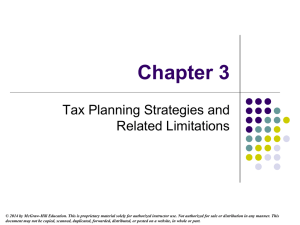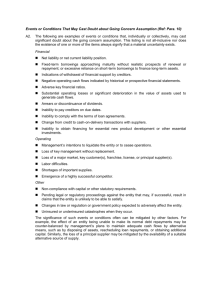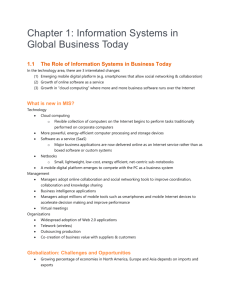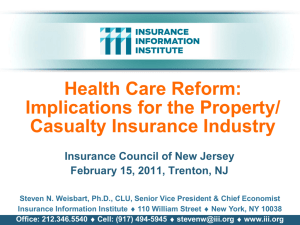Chapter 4
advertisement
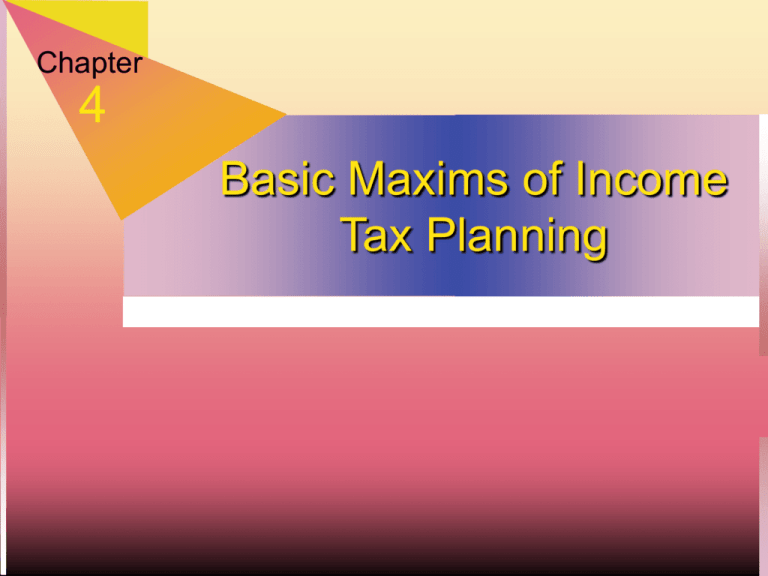
Chapter 4 Basic Maxims of Income Tax Planning Tax Avoidance and Basic Tax Planning Avoidance is legal Tax evasion is a federal crime This course teaches tax planning (avoidance), not evasion – General Rule: Defer tax payments for as long as possible within the realm of the law Income Tax Planning - Entity Generally, taxable income is basically computed the same for different entities. However, the amount of tax paid depends on the difference in tax rates across entities. The two primary tax paying entities are corporations and individuals. Income Tax Planning - Entity Individual taxpayers have a progressive tax rate structure that ranges from 10% to 35% (as of May 2003) see the inside front cover of text. Corporate taxpayers have a progressive tax rate structure that ranges from 15% to 35% for richest corporations. see the corporate tax rates in text. Marginal rates of 38% and 39% eliminate benefits of lower brackets. Income Tax Planning - Entity Income Shifting Arrange transactions to transfer income from a high tax rate entity to a low tax rate entity or from a high rate tax year to a low tax rate year. Deduction Shifting Arrange transactions to transfer deductions from a low tax rate entity to a high tax rate entity or from a low rate tax year to a high rate tax year. Assignment of Income Doctrine prohibits shifting of income from property UNLESS the property is transferred also. Income shifting during periods of changing rates may compete with general tax deferral maxim. Income Tax Planning - Time Because income is reported only once a year, the tax paid or tax savings from any transaction depends on the year the transaction occurs. In present value terms, tax costs decrease (and cash flows increase) when a tax liability is deferred until a later taxable year. Limited by: Opportunity Costs Tax Rate Changes Income Tax Planning - Time Opportunity Costs Shifting tax liabilities to a later period also may entail shifting income to a later period. Thus, the opportunity costs of shifting the income may be greater than the tax savings associated with the liability deferral. Tax Rate Changes If taxpayers defer a tax liability to a future date and Congress increases tax rates the benefits of the deferral may be lost or substantially limited. Income Tax Planning - Character Ordinary income: generated by the routine operations of a business or investment activity and is subject to tax at regular tax rates. This includes service income, sales, interest, royalties, and rents. Capital income generated by the sale of capital assets (see chapter 8) and has consistently been subject to lower tax rates than ordinary income. (e.g. 15% for individuals) (Now some dividends too) Some income is nontaxable. E.g.: Municipal bond income, many fringe benefits. Taxpayers look to convert ordinary income into capital where possible for rate benefit. Tax Law Doctrines Business Purpose Doctrine - must have a business purpose other than tax avoidance. Substance Over Form Doctrine - IRS can look through legal formalities to determine economic substance. Ability to Pay Doctrine: Generally requires a realization transaction to have item subject to tax Return of Capital Doctrine: Return of original investment made with after tax dollars not subject to tax.

